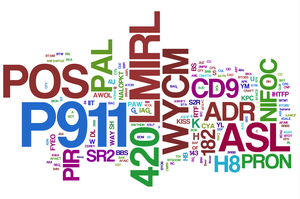By Dr. Ken Broda Bahm:
I’m monitoring a criminal trial this week, and at the end of opening statements, the judge looked at the jury and said, “Okay, both sides have been referring to ‘AUSAs’ — they know what that means and I know what that means, but I’m guessing that you don’t know that that means?” Head nods from the jury. “It means ‘Assistant U.S. Attorney,'” continued the judge, “so please fill that in wherever you hear it.” Good solution? Better than nothing. But it would have been best if both sides would have simply used the title instead of abbreviating it. The tiny amount of additional time it takes to say “Assistant U.S. Attorney” rather than “AUSA” is well worth it in terms of clarity and understanding.
But some attorneys, experts, and other witnesses continue to love the economy of the acronym. But particularly in spoken communication, and particularly in front of a jury, that economy comes at a cost: meaning lost in translation and increased cognitive workload even when it is translated. Practical persuaders before a lay audience are well advised to avoid acronyms almost entirely. Okay, I say almost entirely — there are some exceptions (and besides “Generally Avoid Acronyms” would have been “GAA.”) The few acronyms that ought to still be used are those that have such widespread familiarity that they almost become words in their own right: USA, CNN, or ASAP. In all other cases where the acronyms don’t benefit from automatic translation, the litigator is best off choosing the full expression and not the acronym. This post takes a look at a few reasons, implications, and replacements for trial persuaders looking to lose the alphabet soup of acronyms.
An entertaining piece on acronyms by professional trainer Helen Moody begins with this quote:
“…before the design proceeds to FPU, it must go through PPI and TMS. Only then will the QA department of the DA issue a QER.”
Those words, from the ironically-named Earl Shakespeare, are absolutely opaque to anyone who does not speak his secret code. I also found another article, in a tone that is at least intended to be serious, focusing on the use of acronyms in online communications. The author swiftly creates an acronym for “Three Letter Acronyms” (TLA’s), and then adds in a bevy of other acronyms until the work becomes impenetrable by the third paragraph. Clearly, there is a point where acronyms defeat their purpose. Attorneys in front of juries, however, shouldn’t look for that point, but should instead simply stop using acronyms. Here are a few reasons and implications connected to that.
AAFWNS: Acronyms Are For Writers, Not Speakers
The original motives for using acronyms were to preserve page space and conserve printer’s ink. A writer saves real estate on the page by adopting the habit of spelling out the acronym on first use, and then switching to sole use of the acronym after that. Now that can be an annoying habit in writing as well, because it causes the reader to do what’s called a “loop back” to scan back up the page to find where the acronym is first spelled out. Distracting for a reader, but for a listener, that can be downright impossible. The only “loop back” a listener has is her memory, and while accessing that memory, the listener is likely to miss more words. That is the problem in using acronyms: Even when listeners can figure out what they mean, that figuring taxes their cognitive load, taking a little away from the finite brain space needed for attention, understanding, and retention.
KAOD: Keep Acronyms Off Demonstratives
One place in the courtroom where there is still a premium on printed space is on the demonstrative exhibits. Lawyers and designers who want to keep their trial graphics simple, clean, and uncluttered might be tempted to replace long names with acronyms. Where the acronym is very familiar, FDA for example, its use is economical. But wherever the acronym would fail to stand on its own, it is better to find the space for the complete name. If nothing else, that eliminates one small distraction and allows jurors to immediately grasp the labels and begin processing the imagery at the heart of the demonstrative exhibit.
RAWKW: Replace Acronyms With Key Words
Forswearing the use of acronyms does not mean one needs to keep using long and unwieldy titles over and over again. Instead, it will make more sense to jurors if you boil it down in a way that retains its core meaning. For example, if you’re frequently referring to a “Regular Employee Family or Medical Leave Request Form,” then instead of shortening it to the nonsensical “REFOMLR,” it is more meaningful to simply call it the “Leave Request” once you’ve shared the full name once. The shorthand reference will always be more meaningful than the acronym, and will often be as economical, or more so.
One interesting note is that the abbreviations that end up being familiar and comfortable end up being the ones that are pronounceable: FEMA, NASA, COLA, FIFA, etcetera. When pronounceable, they end up sounding and working just like words. In the case of long-term acronyms — take ‘Scuba’ or ‘Radar’ for example — we may have even forgotten that they were acronyms to begin with. But this phenomenon where the acronym becomes a word is limited, to my knowledge, to cases where the label is spoken rather than spelled out.
So if your acronym sounds like a word, then it might be an exception to the rule. But the rule is, Don’t Use Acronyms.
______
Other Posts on Simplifying:
- Time Your Arguments to the Judge’s Lunch Breaks (and Adapt to All Decision Makers’ “Cognitive Load”)
- Become a Two Minute Expert: Robert Reich Explains What’s Wrong With the Economy
- In Employment Cases (and All Cases), Keeping it Simple is Smart
- Experts: Use Small Words
______
Image Credit: Gerry, Flickr Creative Commons
